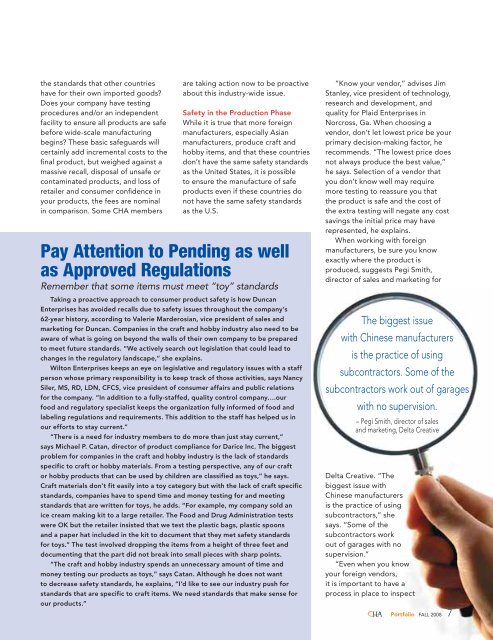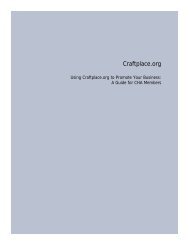Product Safety - Craft & Hobby Association
Product Safety - Craft & Hobby Association
Product Safety - Craft & Hobby Association
You also want an ePaper? Increase the reach of your titles
YUMPU automatically turns print PDFs into web optimized ePapers that Google loves.
the standards that other countries<br />
have for their own imported goods<br />
Does your company have testing<br />
procedures and/or an independent<br />
facility to ensure all products are safe<br />
before wide-scale manufacturing<br />
begins These basic safeguards will<br />
certainly add incremental costs to the<br />
final product, but weighed against a<br />
massive recall, disposal of unsafe or<br />
contaminated products, and loss of<br />
retailer and consumer confidence in<br />
your products, the fees are nominal<br />
in comparison. Some CHA members<br />
are taking action now to be proactive<br />
about this industry-wide issue.<br />
<strong>Safety</strong> in the <strong>Product</strong>ion Phase<br />
While it is true that more foreign<br />
manufacturers, especially Asian<br />
manufacturers, produce craft and<br />
hobby items, and that these countries<br />
don’t have the same safety standards<br />
as the United States, it is possible<br />
to ensure the manufacture of safe<br />
products even if these countries do<br />
not have the same safety standards<br />
as the U.S.<br />
Pay Attention to Pending as well<br />
as Approved Regulations<br />
Remember that some items must meet “toy” standards<br />
Taking a proactive approach to consumer product safety is how Duncan<br />
Enterprises has avoided recalls due to safety issues throughout the company’s<br />
62-year history, according to Valerie Marderosian, vice president of sales and<br />
marketing for Duncan. Companies in the craft and hobby industry also need to be<br />
aware of what is going on beyond the walls of their own company to be prepared<br />
to meet future standards. “We actively search out legislation that could lead to<br />
changes in the regulatory landscape,” she explains.<br />
Wilton Enterprises keeps an eye on legislative and regulatory issues with a staff<br />
person whose primary responsibility is to keep track of those activities, says Nancy<br />
Siler, MS, RD, LDN, CFCS, vice president of consumer affairs and public relations<br />
for the company. “In addition to a fully-staffed, quality control company….our<br />
food and regulatory specialist keeps the organization fully informed of food and<br />
labeling regulations and requirements. This addition to the staff has helped us in<br />
our efforts to stay current.”<br />
“There is a need for industry members to do more than just stay current,”<br />
says Michael P. Catan, director of product compliance for Darice Inc. The biggest<br />
problem for companies in the craft and hobby industry is the lack of standards<br />
specific to craft or hobby materials. From a testing perspective, any of our craft<br />
or hobby products that can be used by children are classified as toys,” he says.<br />
<strong>Craft</strong> materials don’t fit easily into a toy category but with the lack of craft specific<br />
standards, companies have to spend time and money testing for and meeting<br />
standards that are written for toys, he adds. “For example, my company sold an<br />
ice cream making kit to a large retailer. The Food and Drug Administration tests<br />
were OK but the retailer insisted that we test the plastic bags, plastic spoons<br />
and a paper hat included in the kit to document that they met safety standards<br />
for toys.” The test involved dropping the items from a height of three feet and<br />
documenting that the part did not break into small pieces with sharp points.<br />
“The craft and hobby industry spends an unnecessary amount of time and<br />
money testing our products as toys,” says Catan. Although he does not want<br />
to decrease safety standards, he explains, “I’d like to see our industry push for<br />
standards that are specific to craft items. We need standards that make sense for<br />
our products.”<br />
“Know your vendor,” advises Jim<br />
Stanley, vice president of technology,<br />
research and development, and<br />
quality for Plaid Enterprises in<br />
Norcross, Ga. When choosing a<br />
vendor, don’t let lowest price be your<br />
primary decision-making factor, he<br />
recommends. “The lowest price does<br />
not always produce the best value,”<br />
he says. Selection of a vendor that<br />
you don’t know well may require<br />
more testing to reassure you that<br />
the product is safe and the cost of<br />
the extra testing will negate any cost<br />
savings the initial price may have<br />
represented, he explains.<br />
When working with foreign<br />
manufacturers, be sure you know<br />
exactly where the product is<br />
produced, suggests Pegi Smith,<br />
director of sales and marketing for<br />
The biggest issue<br />
with Chinese manufacturers<br />
is the practice of using<br />
subcontractors. Some of the<br />
subcontractors work out of garages<br />
with no supervision.<br />
– Pegi Smith, director of sales<br />
and marketing, Delta Creative<br />
Delta Creative. “The<br />
biggest issue with<br />
Chinese manufacturers<br />
is the practice of using<br />
subcontractors,” she<br />
says. “Some of the<br />
subcontractors work<br />
out of garages with no<br />
supervision.”<br />
“Even when you know<br />
your foreign vendors,<br />
it is important to have a<br />
process in place to inspect<br />
Portfolio FALL 2008 7



